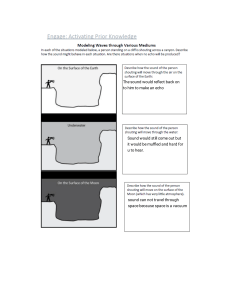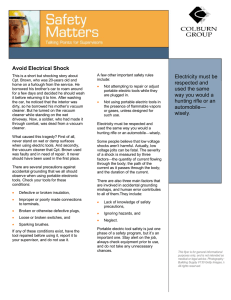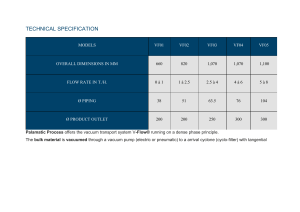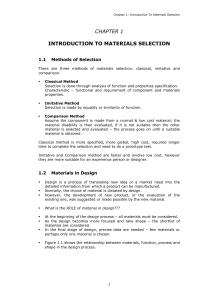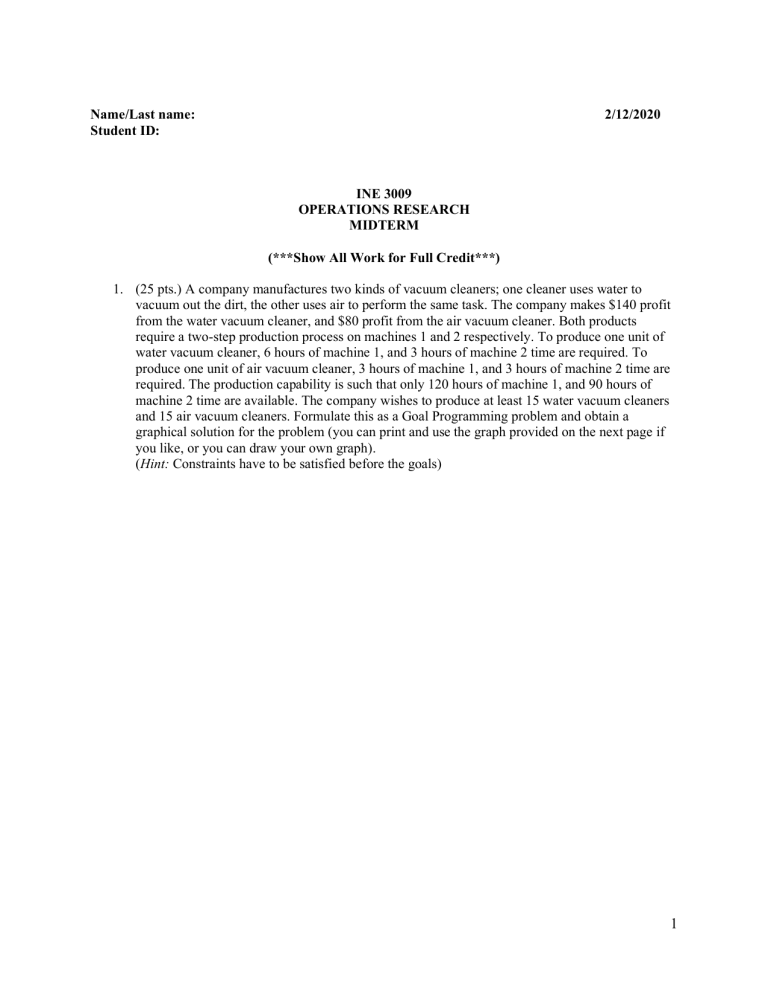
Name/Last name: Student ID: 2/12/2020 INE 3009 OPERATIONS RESEARCH MIDTERM (***Show All Work for Full Credit***) 1. (25 pts.) A company manufactures two kinds of vacuum cleaners; one cleaner uses water to vacuum out the dirt, the other uses air to perform the same task. The company makes $140 profit from the water vacuum cleaner, and $80 profit from the air vacuum cleaner. Both products require a two-step production process on machines 1 and 2 respectively. To produce one unit of water vacuum cleaner, 6 hours of machine 1, and 3 hours of machine 2 time are required. To produce one unit of air vacuum cleaner, 3 hours of machine 1, and 3 hours of machine 2 time are required. The production capability is such that only 120 hours of machine 1, and 90 hours of machine 2 time are available. The company wishes to produce at least 15 water vacuum cleaners and 15 air vacuum cleaners. Formulate this as a Goal Programming problem and obtain a graphical solution for the problem (you can print and use the graph provided on the next page if you like, or you can draw your own graph). (Hint: Constraints have to be satisfied before the goals) 1 2 2. (25 pts.) Seervada Park has recently been set aside for a limited amount of sightseeing and backpack hiking. Cars are not allowed into the park, but there is a narrow, winding road system for trams and for jeeps driven by the park rangers. This road system is shown in Figure below where location O is the entrance into the park; other letters designate the locations of ranger stations. There is a limit on the number of trams the management can secure on each road. The numbers on the arcs give the number of trams that can travel on the roads during one hour. The park contains scenic wonder at station T. Each hour park visitors enter the park, get on the trams and travel through each station and reach station T to watch the scenic wonder before they exit the park at this station. Park management would like to determine maximum number of trams, carrying sightseers that can be sent from location O to location T. (Note: Write down the path for each iteration, NO CREDIT will be given otherwise) 3 A 1 T 0 5 B 9 B O 4 7 D 0 B B B 5 4 B 1 B E C 6 4 3 3. (25 pts.) A pharmaceutical manufacturer must supply 30 batches of its new medication in the next quarter, then 25, 10, and 35 in successive quarters. Each quarter in which the company makes product requires a $100,000 setup, plus production cost of $3000 per batch produced. There is no limit on production capacity. Batches can be held in inventory, but the cost is a high $5000 per batch per quarter. The company seeks a minimum total cost production plan. Show a network representation of the problem. 4. (25 pts.) Powerco has three electric power plants that supply the needs of four cities. Each power plant can supply the following numbers of kilowatt (kWh) of electricity; plant 1-35 million; plant 2-50 million; plant 3-40 million. The peak power demands in these cities (kWh) are as follows: city 1-45 million, city 2-20 million, city 3-30 million, city 4-30 million. The cost of sending 1 million kWh of electricity from plant to city depend on the distance the electricity must travel. The shipping costs are shown in the following table. Use the transportation model to minimize the total transportation cost and find the new Z value. ****Show only the first iteration**** To From Plant City 1 City 2 City 3 City 4 1 $8 $6 $10 $9 2 $9 $12 $13 $7 3 $14 $9 $16 $5 4
